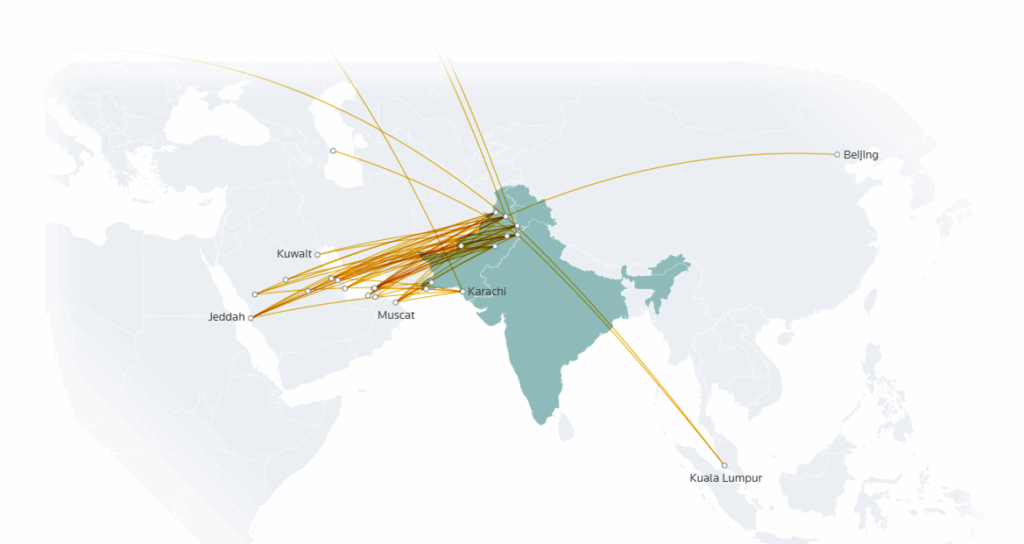- Web Desk
- 10 Minutes ago

How India-Pakistan conflict pushed planes off course
-
- Reuters
- May 08, 2025

Fresh tension between India and Pakistan has hit the commercial aviation industry, forcing rerouting of flights and cancellations.
India said it struck nine Pakistani “terrorist infrastructure” sites on May 7, some of them hundreds of kilometers inside Pakistan, while the latter claimed to have shot down five Indian fighter jets. The strikes came two weeks after an attack in Indian Occupied Kashmir killed 26 people, which India blamed on terrorists backed by Pakistan.
Following India’s military strikes, several airlines said they were re-routing or cancelling flights over or near the region. Dozens of flights were cancelled or diverted to avoid Pakistan’s airspace, flight-tracking website FlightRadar24 showed. Several airports were also shut in northern India.
Even as the fresh tension led nearly all aircraft to stay away from Pakistan and northern India, the rerouting of some flights had began earlier.
India unveiled a slew of measures against Pakistan last month, including suspending a water-sharing pact, soon after the terror attack in Indian Occupied Kashmir. In retaliation, Pakistan shut its airspace to Indian airlines on April 24, amid other measures. India retaliated by shutting its airspace to Pakistani carriers.
India relies heavily on Pakistan airspace
These are all the routes scheduled by Indian airlines in the first week of May touching the country’s top 15 international airports, according to FlightRadar24. The airlines operate close to 4,000 direct flights a week across more than 200 routes linking 61 international destinations.

The routes that cross Pakistan account for 20% of Indian flights with foreign destinations and 30% of their flights heading west. These primarily connect with the northern Indian cities of Amritsar and Lucknow, besides the capital, New Delhi.

For airlines from Pakistan, on the contrary, 99% of their flights do not need to fly through Indian airspace. As a result, only eight flights a week that Pakistan International Airlines operates to Kuala Lumpur and Beijing are potentially affected by the ban India imposed on Pakistani airlines.

Not all Indian airlines’ flights are equally affected. Some need a very short detour to bypass airspace over Pakistan, such as connections between New Delhi and Nairobi or the city of Lucknow and Muscat.
Added flight time
A Reuters analysis of 75 daily flights between the northern Indian cities of Delhi, Amritsar and Lucknow and destinations requiring them to cross Pakistan shows their duration increased by 47 minutes on average after Pakistan shut its airspace on April 24.
The increase in duration ranged from a few minutes for flights linking Delhi with Doha, Jeddah and Dubai in the Middle East, to as much as four hours for flights connecting Delhi with the cities of San Francisco in the United States and Vancouver in Canada.

On average, flights with the Americas added 2.8 hours to flying time, excluding fuelling stopovers, while flights to European cities added more than an hour on average. Flights connecting the Middle East were the least affected, lengthened by an average of 18 minutes.
Wide range of impact
Flights connecting Delhi with Central Asia were badly affected, made longer by the need to go all the way around Pakistan.
India’s leading airline, IndiGo, cancelled direct flights to Tashkent in Uzbekistan and Almaty in Kazakhstan for at least 10 days, saying limited rerouting options placed the destinations “outside the operational range” of its current fleet.

The routes that have added the most to their flight time connect New Delhi with destinations in the United States and Canada. Some have had passengers stay on the aircraft for an additional five to six hours, which includes a refuelling stopover in Europe.
The long detours and stopovers mean higher fuel costs for the airlines and longer journey times for passengers and crew, in light of which India’s aviation regulator has allowed Air India to temporarily extend maximum duty hours and rest periods for pilots on long-haul routes. Air India was expecting to face additional costs of about $600 million if Pakistan’s airspace ban were to last for a year.

For Pakistan’s largest carrier, Pakistan International Airlines, only two routes linking the cities of Islamabad and Lahore with the Malaysian capital of Kuala Lumpur stand to be affected by the Indian airspace ban. Its only other route connecting an eastern location is Islamabad–Beijing, which had bypassed Indian airspace even before the current conflict.

Besides carriers from India and Pakistan, some European airlines had also started rerouting some long-haul flights around Pakistan at least a week before India’s May 7 strikes. These include Air France, Lufthansa, Swiss International Airlines and British Airways, a list from FlightRadar24 shows.
Citing “recent evolution of tensions” between India and Pakistan, Air France said it was suspending “overflight of Pakistan until further notice”. Lufthansa also confirmed it was “avoiding Pakistani airspace until further notice”.

The airspace ban has an impact beyond rerouting of flights and associated costs. Pakistan may see a drop in its earnings from overflight fees, which can run into hundreds of dollars a flight.






